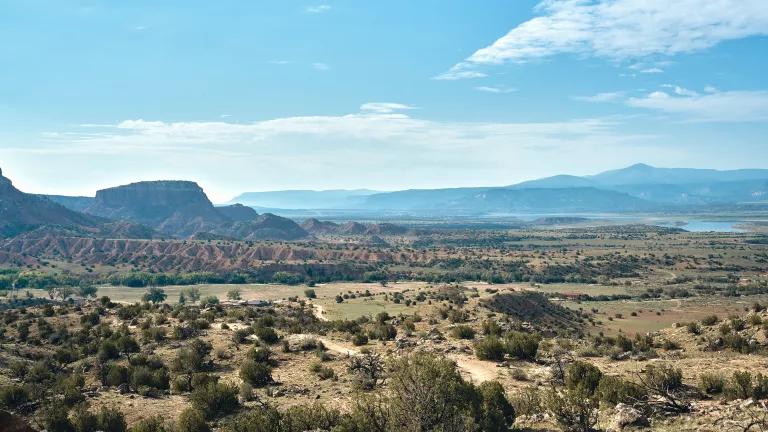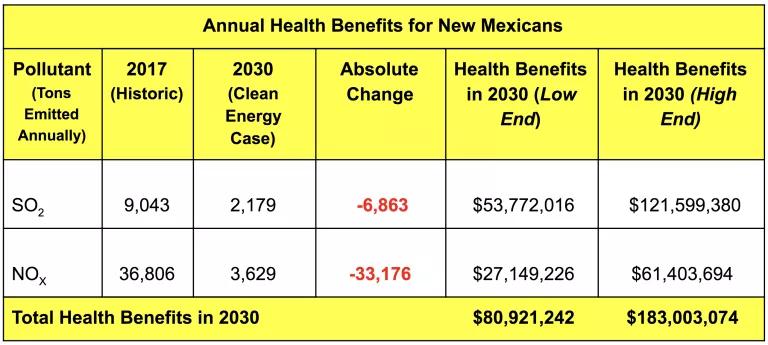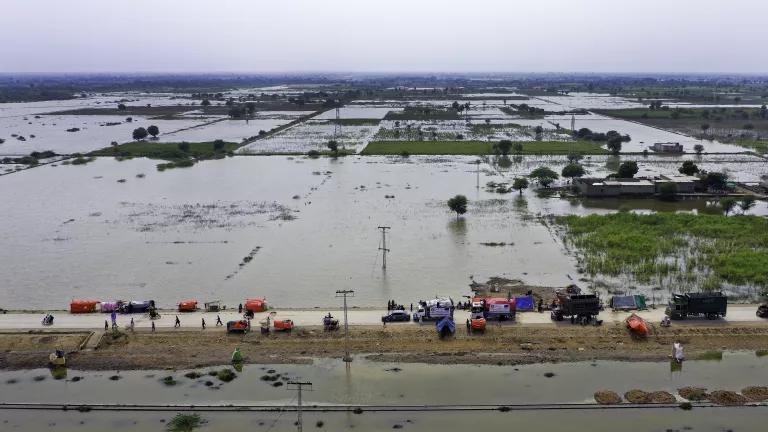Cleaner Air, Better Health in NM’s Clean Energy Future

Research and analysis for this blog was conducted with the help of Amanda Levin and Patricia Valderrama.
New modeling finds that New Mexico would reap substantial benefits from a 50 percent renewable energy standard in combination with increased energy efficiency savings. These improvements would lower harmful air pollution across the state, improve public health, and provide cheaper energy to customers by 2030. For a complete description of our methodology and results, read these blogs.
Cleaner Air and Better Health
The modeling shows that New Mexico would have cleaner and healthier air by 2030 in a clean energy future. Specifically, nitrogen oxides (NOX) and sulfur dioxide (SO2) emissions from the state’s power sector would fall by 90 percent and 76 percent, respectively, compared to 2017 levels. These pollutants are emitted when we burn fossil fuels—like coal and gas—to generate electricity. Coal-fired power plants are a significant source of both NOX and SO2, while gas plants produce NOX and other gases. Decreasing emissions from NOX and SO2 is vital to public health in New Mexico, because exposure to these two chemicals can lead to asthma attacks, hospitalizations for cardiac or respiratory conditions, ER visits, and even premature deaths.
NOX refers to a family of chemicals that contribute to smog and can have serious health effects, especially for infants and children. Studies conducted by federal and state agencies have shown it can worsen allergies and aggravate respiratory issues, especially for children. That results in more coughing, wheezing, difficulty breathing, asthma attacks, and increased ER visits related to these respiratory problems or even premature death. NOX has even been linked to decreased lung function growth in children, meaning children who grow up with long-term exposure to NOX have smaller lungs than children with access to cleaner air.
SO2 has been shown to have similar negative health impacts, especially for the elderly and children or adults with asthma. Sulfur dioxide irritates and inflames our noses, throats, and airways, which can make breathing difficult or painful, especially for those with pre-existing cardiovascular and pulmonary diseases (like asthma). It can also worsen existing heart disease.
Both NOX and SO2 also interact with other gases and dust in the atmosphere to help create particulate matter (PM) and ground-level (or “bad”) ozone. Particulate matter is too small for us to see with the naked eye, but it is far from harmless. Small enough to inhale, it wreaks havoc once it is in our lungs and bloodstream. Exposure to PM has been associated with more premature deaths, as well as increased emergency room visits and hospital admissions for lung and heart problems. Breathing ozone is linked to similar health problems and can also have serious harmful effects on our ecosystems and sensitive lands, like forests, national parks, wildlife refuges, and wilderness areas.
Reductions in these harmful air pollutants could result in between $80.9 million and $183 million of estimated annual health benefits for New Mexicans in 2030.

We calculated these estimates using standard benefit-per-ton estimates developed by the U.S. Environmental Protection Agency. The federal agency uses a three-step process to arrive at its benefit-per-ton estimates. First, it uses air quality modeling to predict changes in the concentrations of specific pollutants, like particulate matter, NOX, and SO2, across different regions in the U.S. Then, it combines estimates of human health responses to these air pollutants drawn from peer-reviewed scientific literature with population data, baseline health information, and economic valuation information. It uses this information to quantify the adverse health effects of these air pollutants. Finally, it estimates the economic value of avoiding those health problems by considering, to use one example, the cost of hospitalization for a respiratory condition. The scientific literature includes a range of reasonable estimates of the health impacts of air pollution. Those vary from person to person, which is why the total health benefits are shown as upper and lower bounds above.
Cutting Carbon Will Also Protect Public Health and the Environment
A stronger RPS and energy efficiency target would also reduce the state’s carbon footprint. Carbon dioxide (CO2) is the largest source of climate-warming greenhouse gases in the U.S. and globally. CO2 emissions from power plants in New Mexico would be 40 percent lower in 2030 in the Clean Energy Case, compared to the state’s emissions in 2017.
Lowering CO2 emissions helps protect the Land of Enchantment for current and future generations of New Mexicans while protecting their health and welfare. New Mexico is the sixth-fastest-warming state in the country. It currently faces 20 days per year on average that are classified as dangerously hot—a number that is projected to double by 2050 because of global warming. Climate models predict that residents of Albuquerque, an urban heat island, could confront as many as 27 days with a heat index above 105 degrees by the middle of the century. Low-income children and elderly people are especially vulnerable to the impacts of heat waves. That puts 80,000 New Mexicans at higher risk from extreme heat. The state’s agricultural regions are already feeling the impact of drought, as water becomes more expensive and harder to reach. Unfortunately, summertime droughts are only predicted to get longer if we don’t start cutting down on greenhouse gas emissions. In addition, 1.4 million people, or the equivalent of 70 percent of the state’s population, currently live in areas that face elevated risk of wildfires in the coming decades. Wildfires affect everyone, but recovery is often much more difficult for low-income and already vulnerable people.
As temperatures rise, people will naturally use more air conditioning. On dangerously hot days, access to air conditioning is a serious health issue. Clean energy policies that pair renewable energy generation and energy efficiency create a scenario where utilities, humans, and the environment all benefit. With higher energy efficiency, spikes in demand from increased AC usage avoid straining the state’s energy infrastructure while people have access to the cooling they need to stay healthy. And using clean energy to meet those demand spikes avoids an increase in the greenhouse gas emissions that would further jeopardize the health and safety of New Mexicans and their ecosystems.
New Mexico can shrink its carbon footprint by implementing a 50 percent renewable portfolio standard and a 1.8 percent energy efficiency standard. Decreasing CO2 emissions would mitigate the impact of global warming on the state and make important steps toward preserving the quality of life of current and future generations of New Mexicans.




